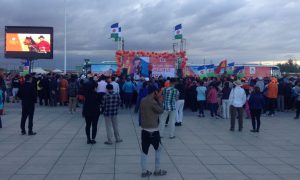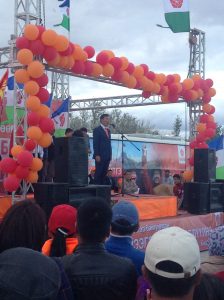By Julian Dierkes
Note: I wrote this post on June 21 and was in the countryside without WiFi. Since then, more “revelations” about the illegal donation Ganbaatar is alleged to have accepted, have come out. That information is not reflected in this post.
In the last days of the campaign, there are lots of whispers about the various poll results that the parties have, giving them hints about leaders in the race to become president. Those polls are not published (and would be illegal to publish under the election law) and they are never revealed after the election to show how they performed in predicting outcomes.
However, given the methodological challenge that all surveys in Mongolia face (few landlines, multiple cell phone lines, how to sample in countryside, lack of social statistics to be able to construct a valid sample, etc.), I doubt that these internal polls are of such a quality that they actually predict much, even though many if not most of the empirical Mongolian social scientists seem to be involved in polling of some kind during the election season.
Further confirmation that the polls might not be of great methodological soundness comes in the fact that I have now heard very confident 2nd-hand-reports from various directions that have any of the three candidates leading. “Oh, the MPP is panicking, Ganbaatar is in the lead.” “The DP is really revving up its campaign since Battulga has managed to grab the lead”, etc. I generally discount these whispers.
Of course, my impressionistic prediction is no better than a poll, but at least it is my own impressions that contribute to it.
Second MPRP Rally: Dalanzadgad
By pure travel accident, I saw Ganbaatar and a MPRP rally for the second time during this campaign while I have yet to see either of the other candidates live.
 Ganbaatar appeared in the early evening of June 21 in Dalanzadgad, capital of Umnugovi. He spoke on a large square in front of the beautiful naadam stadium.
Ganbaatar appeared in the early evening of June 21 in Dalanzadgad, capital of Umnugovi. He spoke on a large square in front of the beautiful naadam stadium.
The crowd was even smaller than when I saw him speak in Tsetserleg earlier in the campaign, no more than a 1,000. As in the earlier event, the audience was dominated by older people and flag-waving and cheering party workers.
As is probably typical of most public rallies like this, local grandees and celebrities spoke before and after Ganbaatar’s speech. There were rows of flag-bearers arranged around the square and the stage was festooned with balloons. There was a large screen that played a loop of Ganbaatar campaign commercials. Somewhat funnily, there was a DP campaign ger right behind the screen so that the DP party flags were fairly visible from the main square.
Protest Movement
Ganbaatar was not a MPRP member before his nomination and was a member of parliament as an independent. He was anointed the MPRP candidate by N Enkhbayar the undisputed leader of the MPRP. The party’s calculus must have been that since their candidate would have an outside chance at best, might as well nominate a prominent candidate who would cement the party’s reputation as a guardian of the people’s uneasiness with MANAN (MPP-DP dominance).
But to have a shot at making it into a second round at least, Ganbaatar would have had to expand his appeal significantly beyond the MPRP’s which was well under 10%. The main opportunity was thus the personal appeal of the candidate and the building of momentum via a protest movement.
Ganbaatar’s Appeal
At the two public rallies I witnessed, I saw neither much personal appeal, nor evidence of an enthused protest movement.
Ganbaatar’s speeches were relatively short and he is not a powerful speaker. He was generally left standing by himself at the microphone and does not have gestures that liberate him from that slightly awkward set-up.
 Supporters dutifully cheered (mostly on cue), but in Tsetserleg they were much more enthusiastic in cheering Enkhbayar and in Dalanzadgad much less enthusiastic in cheering Oyunbat, former MP from the aimag, and presumed local favourite to lead this rally. Looking at the crowd from the stage’s perspective, I did not see rapt or even particularly interested listening.
Supporters dutifully cheered (mostly on cue), but in Tsetserleg they were much more enthusiastic in cheering Enkhbayar and in Dalanzadgad much less enthusiastic in cheering Oyunbat, former MP from the aimag, and presumed local favourite to lead this rally. Looking at the crowd from the stage’s perspective, I did not see rapt or even particularly interested listening.
He did vary his speech, for example, toning down his stance on Oyu Tolgoi and other large mining projects (source of employment and wealth in Umnugovi, of course), by emphasizing that he was only asking questions about the contracts and agreements regarding these projects, not fundamentally questioning them.
Lack of Enthusiasm
Overall, the event was fairly lacklustre. It did not impress me as a nascent or blooming protest movement.
Of course, much of the campaign is playing out in the media, broadcast and social, so I would not suggest that we can draw conclusions on the basis of two rallies, but given the uphill battle that the Ganbaatar was facing, I did not come away from these events expecting to be surprised by results on June 26.

 Follow
Follow